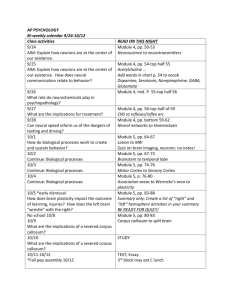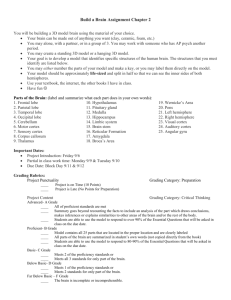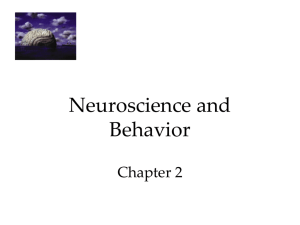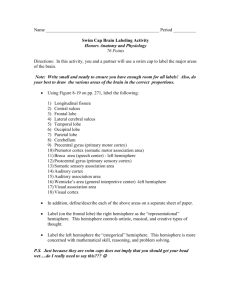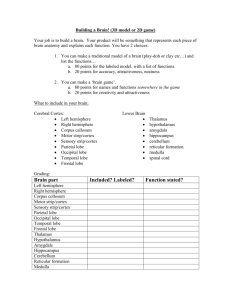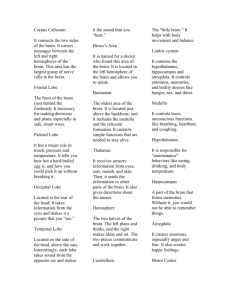The Brain and The Nervous System
advertisement
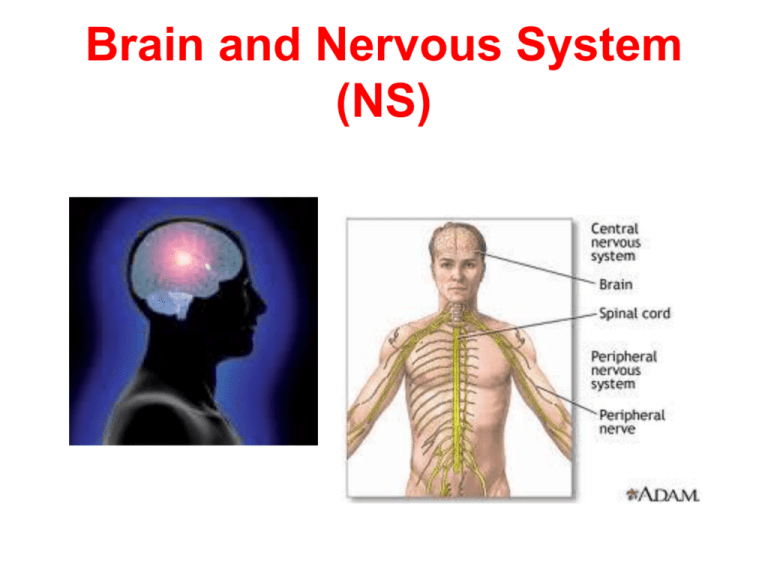
Brain and Nervous System (NS) Nervous System Made up of neurons - 2 main types • 1) Central NS • 2) Peripheral NS Central Nervous System • Role: coordinates incoming info and initiates outgoing messages/behaviours. • Consists of brain and spinal cord. • Brain = controls the decisions • Spinal cord = communication between the brain and PNS. (sensory info inwards and motor info outwards) - coordinates reflexes. • Note – • Spinal cord does not carry signals between the CNS and PNS – this is wrong as the spinal cord is part of the CNS. • Must be Brain to PNS Neurons • Building blocks of the nervous system that carry messages as an electrical impulse. • E.g. = what you touch must travel from your hand to your brain to be understood and then from your brain to your hand for a response to occur Watch • http://www.youtube.com/watch?v=CMnDie pv5Os • http://www.youtube.com/watch?v=vyNkAu X29OU 3 kinds of neurons • 1) Sensory Neurons “AFFERENT”: respond to sensory receptors then send signals to the CNS. Transmit info inwards. • 2) Motor Neurons “EFFERENT” : Transmit signals from the CNS to specific muscles. Transfer info outwards (Efferent = EXIT) • work together to allow the body to identify a stimuli and then respond to it • 3) Interneuron: connects afferent and efferent neurons in the CNS(mostly at the spinal cord) • Most common!! • Found only in CNS • Responsible for the reflex arc The Reflex Arc • An automatic response in which sensory neurons (inwards) do not pass to the brain • Communicate in the spinal cord = reflex action • Acts as a survival mechanism Parts of a neuron Parts of a Neuron http://www.youtube.com/watch?v=cUGuWh2UeMk • Dendrites: thin extensions of a neuron that receive information from other neurons • Cell Body/soma: contains the nucleus and decides what it will do with the information • Nucleus: contains genetic material (brains of the neuron) • Axon: carries the signals and covered by myelin sheath • Axon Terminals buttons: end of the axon that and release neurotransmitters • Synapse: the junction that permits the transfer of electrochemical messages form cell to cell. Connection point which has the synaptic cleft, neurotransmitters and receptor sites • Synaptic Cleft: small gap between 2 neurons which neurotransmitters cross • Neurotransmitters: chemicals that are released into the synaptic cleft, where they bind to receptor sites on the other neuron receiving the signal. • Receptor Sites: sensitive to neuron transmitters which change the charge of the post neuron Communication between neurons = Action Potential • http://www.youtube.com/watch?v=XGINQ 7xhPkM Communication between neurons = Action Potential • Action Potential = happens during the firing of a neuron. Pre neuron is + and Post neuron is - . Neurotransmitters cross and turn the post neuron +. • Information is transmitted from one neuron to the next via NEUROTRANSMITTERS • Happens at the synapse. Terminal buttons neurotransmitters cross synaptic gap receptor sites next neuron continue the process 1) Pre neuron – signal travels down axon 2) Axon Terminals (at the end of the axon) hold neurotransmitters 3) Neurotransmitters are released into the synaptic gap 4) They bind with receptor sites of the post neuron 5) All this happens at the synapse The Peripheral Nervous System • All nerves outside the brain and spinal cord. • Links the CNS to all other parts of the body • - divided into • A) somatic • B) autonomic Somatic Nervous System • Controls voluntary skeletal muscle movements. • Has a sensory (sends signal via sensory neurons ) and motor function (movement via motor neurons). • EYES • Cutting your finger • Bee sting Anything on the outside of the body • Gathers information from the sensory receptors in the body and transmits this information to the CNS. • Effect movements by carrying motor messages from the CNS to the muscles and glands. The somatic nervous system is responsible for voluntary skeletal muscle movement. • Carries sensory information to the brain and movement information to the body Autonomic Nervous System (PNS) • Modifies automatic (visceral / involuntary) muscles. • Digestion, heart rate, respiration, kidneys • Walking down a dark ally • Divided into 2 which control opposite reactions • 1) Sympathetic NS • 2) Parasympathetic NS Divided into the Parasympathetic NS Calms body down after threat has passed – Returns to ‘homeostasis’ equilibrium Sympathetic NS Readies the body to confront a threat – activates the organism for “Flight or Fight” • Parasympathetic dominates in day to day functioning. • Sympathetic dominates when under threat. • They work in cooperation, • One always dominates depending on the situation Flight or Fight Response • Adaptive purpose with the aim of survival • A state of high arousal that prepares the body to confront a situation or fight it, or, flee from the situation or flight it. • Arousal = general level of alertness. • Confront NOT deal All Physiological Arousals Sympathetic Parasympathetic Eyes Dilate Constrict Heart Increase rate/pumps blood faster Decreases to normal Lungs/Bronchi Expands/relaxes airways Constricts/decreases O2 consumption Salivary Glands Decreases Normal Bladder Relaxes Normal Adrenal Glands Increase Decrease Sex Organs Sweat Glands Increases Inhibits Stomach Slows digestion Normal Physical Responses by the Sympathetic NS - 168 • Pupils dilate – allows to gather info immediately • Tears – inhibited • Heart Rate increases – increase blood flow to working/essential muscles • Bronchi relax/expand – increase O2 consumption • Digestion – inhibited • Salivary glands – decreases/dries up • Adrenaline increase – released to speed up HR • Sugar – increased to provide extra energy • Bladder – relaxes (temporary loss) • Not more blood – we do not get more blood in the body. • • • • Role of the hormones Adrenal glands release adrenaline Allows for burst of energy Takes some time for hormones to leave the blood stream due to increased arousal. • Enter fast and remove slow • http://www.youtube.com/watch?v=tmYGOFhhHE • ____________ neurons carry information from organs and muscles to the central nervous system while ____________ neurons carry information to organs, muscles and glands from the central nervous system. • A. Sensory, motor • B. Motor, sensory • C. Peripheral, autonomic • D. Autonomic, peripheral • The motor function of the somatic nervous system can be demonstrated by • A. experiencing the cold sensation of ice on your skin. • B. reflexively moving your hand away from a hot stove. • C. feeling muscle soreness after playing sport. • D. scratching your head. • The sympathetic and parasympathetic nervous systems • A. are part of the reflex arc. • B. cannot both be active at the same time. • C. have opposite effects although they work together. • D. are inactive unless the fight/flight response is activated. • Which of the following is true of the autonomic nervous system (ANS)? • A. The ANS is a vital part of the central nervous system (CNS). • B. It is impossible to consciously influence the functioning of the ANS. • C. The ANS ensures that the constantly changing energy requirements of the body are met. • D. The ANS relays messages between the CNS and the voluntary muscles that control our internal organs and glands. Questions • Attempting to become part of the Australian Olympic team, Renee is waiting to compete in her 400m trial. In reference to this scenario, explain how Renee’s somatic NS and Autonomic NS (sympathetic and parasympathetic) would work together to help her compete in this race? • 4 marks • Her somatic NS controls voluntary actions via its connections with the skeletal muscles. Renee’s ears would relay the information about the starting gun, and her CNS would send instructions for Renee’s muscle groups in her arms and legs to move. • Her autonomic NS controls involuntary actions of internal organs. At the start of the race her sympathetic NS would be activated, resulting in an increase in Renees’ adrenaline, heart rate, respiration and sweating. After the race her parasympathetic NS would slow her heart rate and respiration rates to restore her body to a balanced state. • http://www.biologymad.com/nervoussyste m/nervoussystemintro.htm - website Brain / Cerebrum - ‘master organ’ – makes the decisions Facts • Weighs 1.4 kg • 100 billion neurons • Structure = what it looks like • Function = what it does Cerebral Cortex Location • Folded outer covering the cerebrum Structure • 2 – 4 mm thick • Largest area of the brain = 2/3 of all neurons • Wrinkled/ folded /convoluted – Increase surface area Function Covers all of the brain therefore, is responsible for all major cognitive functions - Motor coordination Processing of sensory info Higher mental processes – language, thinking, problem solving Personality Comparison of human cerebral cortex to animals Our cortex is more proportionally significant to other areas of the brain (contains 75% of all neurons). • The human brain structure which contains almost three quarters of the brain’s neurons and which is responsible for processing information as well as reasoning, planning and imagining is the • A. frontal lobe. • B. temporal lobe. • C. cerebral cortex. • D. cerebral hemisphere. • The cerebral cortex • A. is wrinkled and this increases the surface area. • B. connects the two hemispheres of the brain. • C. is approximately 3.5 cm thick. • D. controls sleep functions • Which one of the following statements about the human adult brain is correct? • A. The adult brain weighs around 500 g. • B. The brain is divided into sections, each of which has one specifi c function. • C. The brain’s cerebral cortex is folded to increase cortical surface area. • D. The brain is responsible for many bodily functions but not body temperature. • Cerebral Hemispheres • Corpus Callosum - Cerebral Hemispheres • Left and Right • Connected by corpus callosum • Separated by the longitudinal fissure - Corpus Callosum • Is a structure of nerve fibres that allows communication/transfers between the left and right hemispheres • The main function of the corpus callosum is to • A. exchange neurons between hemispheres. • B. process information from both hemispheres. • C. protect the brain from injury. • D. transfer information from one hemisphere to the other. • The two hemispheres of the brain are connected by • A. the cerebral cortex. • B. the corpus callosum. • C. a deep fi ssure that separates all the nerve fi bres. • D. a small strip of tissue with no neurons. • Which of the following statements best describes the corpus callosum? • A. The corpus callosum transfers information between the cerebral hemispheres of the brain. • B. Patients with brain damage are unable to send neural information through the corpus callosum. • C. The corpus callosum ensures that each hemisphere of the brain is able to function independently. • D. The corpus callosum is found in the cerebral cortex, and connects the two hemispheres of the brain. 4 lobes of the Brain (F.TOP) • http://www.youtube.com/watch?v=Vy8Evy QoQIE • Each lobe is divided into 2 basic zones 1) Primary/cortex areas = process some type of sensory information 2) Association area = Integrate information from different parts of the brain (all the other areas other than the primary cortex areas). Makes up 95% of human cortex • Which of the following is the most accurate description of the association areas of the cortex? • A. They are located in the left hemisphere and associate input from the right hemisphere. • B. They integrate information from different parts of the brain. • C. They include the motor and sensory areas in each lobe. • D. They are crucial for providing basic survival needs. Frontal Lobe Cortex area Primary Motor Cortex = controls voluntary skeletal muscle movement on a) The opposite side of the body (left PMC controls right side) b) Amount of cortex is related to precision/dexterity of movement e.g.) fingers and mouth = more area c) Our body is represented upside down on the motor cortex Other Function: Association area Higher order functioning Planning, emotions, personality, reasoning, deciding appropriate social behaviours Dexterity= Fine motor skill is the coordination of small muscle movements which occur in body parts such as the fingers. Homunculus: human figure represents body parts in terms of their space Contralaterally = taking place or originating in a corresponding part on an opposite side. More Area = Fine muscle movements When a basketballer shoots for a goal, which part of the brain sends the message instructing her to raise her shooting arm? A. the somatosensory cortex B. the prefrontal lobe C. the occipital lobe D. the motor cortex Parietal Lobe Cortex Primary Somatosensory = receives touch, pressure, pain and temp sensory message from the body. a) Crossover = receives information from the opposite side of the body b) More space devoted to body parts with most sensors eg) fingers, lips c) Upside down = information from the lower parts of the body is processed at the top Other Functions: Association Area SPATIAL AWARNESS and BODY AWARNESS = where things are in space e.g.) sense of direction Does not receive all sensory information - sounds = PAC - sight = PVC Motor Cortex = precision Sensory Cortex = more sensory receptors Occipital Lobe Cortex Primary Visual Cortex = receives visual information. Step 1 Other Function: Association Area Enables perception/interpretation. Step 2 The Visual Pathway 2 eyes open = opposite hemisphere. 1 eye open = both hemispheres. types of questions on an exam Left visual field = right hemisphere Right visual field = left hemisphere (visual field = the environment on the outside) 1 eye open = both hemispheres as it becomes a central visual field. Visual information received by the right eye = both hemispheres Visual information received by the left eye = both hemispheres Questions about the Visual Field = opposite Hemisphere • Visual images received in the left visual field are processed in the = Right Hemisphere Questions about the eyes = both Hemispheres • the visual information from your left eye would be processed in the = right and left hemispheres Info from the Visual Field = Goes to both eyes (right visual field = left side of the eyes) Visual images received in the left visual field are processed in the A. occipital lobe of the left and right hemispheres. B. temporal lobe of the right hemisphere only. C. occipital lobe of the right hemisphere only. D. occipital lobe of the left hemisphere only. If you put your hand over your right eye, and use your left eye to tell the time on the clock on the wall in the examination room, the visual information from your left eye would be processed in the A. left occipital lobe. B. right occipital lobe. C. somatosensory cortex. D. left and right occipital lobes. Temporal Lobe Cortex Primary Auditory Cortex registering auditory information Step 1 Association Sounds are turned into recognisable info involved in memory, and the ability to recognise faces Step 2 Akmal bumped his head in a heavy fall at a skate park. When he was still recovering in hospital, he could describe a man who came to visit him each day but he could not recognise this man as his father. Akmal has most likely sustained damage to the association area in the cortex of the ______________ lobe. A. occipital B. parietal C. frontal D. temporal Which of the four lobes is typically responsible for receiving and processing auditory information? A. frontal B. parietal C. occipital D. temporal http://www.youtube.com/watch?v=luXDQrmMoUU Language Centres Both verbal and written Area Broca’s Area Wernicke’s Area Hemisphere Left Left Lobe Frontal Lobe Temporal Lobe Function •Controls the muscles associated with language •Producing clear speech using the rules of grammar •Involved in understanding complex grammatical structures •Enables us to understand spoken and written language • Creates meaningful, coherent and grammatically correct speech and writing by locating words. •PRODUCTION •COMPREHENSION Damage Aphasia: language disorder apparent in speech produced by injury to the brain Broca’s Aphasia - You make sense but produce limited speech - Difficulty in small connecting words - Poor use of grammar - Slow and uses verbs and nouns E.G went beach made castle Wernicke’s Aphasia - Difficulty understanding written or spoken language - Can make fluent speech but it is meaningless - Not aware of defect E.G beach made went castle ‘word salad’ Note: Still read and understand the speech of others is not a symptom of Broca’s Aphasia. = The role of Broca’s area. Summary of Aphasia Broca’s Aphasia: When people have damage to Broca’s area their speech becomes slow, laboured and lacks grammatical accuracy, although what they say makes sense. Wernicke’s Aphasia: When people have damage to Wernicke’s area their speech remains fluid (correct pace and intonation), although they use the incorrect words and appear unaware of their deficit. Their speech is often referred to as ‘word salad’ because it is jumbled. Mandy fell off her bike and suffered some mild brain damage. Doctors tested her and found that Mandy could pronounce the word ‘accident’ but she was unable to give a meaningful verbal description of her accident. The doctors were most likely to conclude that the part of Mandy’s brain affected was A. Broca’s area. B. the frontal lobe. C. the parietal lobe. D. Wernicke’s area http://www.youtube.com/watch? v=fFGmCRc0njk – Language Hemispheric Specialisation • Refers to the specialisation/dominance of certain functions by each of hemispheres of the brain. Left Hemisphere (verbal and analytical functions) Right Hemisphere (non verbal functions) Behavioural Functioning Motor control of voluntary muscles on right side of the body Also muscles involved with speaking Motor control on left side Cognitive Functioning Verbal understanding, production of reading & writing, spelling Analytical Tasks: Logical, Sequential Thinking, Problem Solving Tasks that involve breaking things into steps Maths (+, -, x, /) and science Non-verbal thinking Understanding music and pictures. Reading a map. Creativity, Colour Using imagination, fantasy Identifying faces Detection/expression of emotions Spatial activities – jigsaw puzzles Recognises melodies Holistic approach – all at once Hemispheric Specialisation • Research has found that damage to the right hemisphere often resulted in difficulties with visual and spatial tasks such as reading maps. • Damage to left hemisphere often resulted in difficulties with language related tasks such as understanding speech, talking fluently reading and writing. • Damage to the right hemisphere often result in slower recognition of pictures. Can we be labelled a left or right brained person? • NO = Although each hemisphere can be dominant or specialise in a distinguishable function, both hemispheres are involved in nearly all functions working together in an interactive way. Left = understanding and producing speech Right = identify sarcasm, understanding jokes, irony ect… http://www.youtube.com/watch?v=t2pEGEdLBVg – summary Recent research has shown that abilities in subjects such as math are actually strongest when both halves of the brain work together. Today, neuroscientists know that the two sides of the brain work together to perform a wide variety of tasks and that the two hemispheres communicate through the corpus collosum. • Evidence for hemispheric specialisation comes from two sources of investigation 1. People with damaged brains (including split brain surgery). – Roger Sperry or spatial neglect. 2. People with intact brains Damaged brains • Sperry & Gazzaniga • Split Brain Surgery: corpus callosum connecting the 2 hemispheres is cut Known as - Commissurotomy • individuals were said to have a ‘split-brain’ b’c hemispheres could not communicate. Aimed to stop seizures. • Clip on split brain Experiment Step 1) seated in front of a screen. Participants fixed their sight on a point (black dot) in the centre of the screen. - Visual stimuli are projected onto the left or the right side of a black dot. • Step 2) the person needs to demonstrate what they have seen. They can do this in one of three ways: • A) they can say out loud what they have seen (only of it is flashed to the right side) • B) they can reach for and touch the accompanying object that is placed on the other side of the screen (can do it with opposite hand), • C) they can draw the image (if flashed to the left visual field and will use left hand). Results from split brain patients • Damage to the right hemisphere usually leaves language unaffected • When words/pictures were presented quickly in the right visual field (processed in left hemisphere) patients could describe what they had seen (because the left hemisphere specialises in language) • When words/pictures presented in the left visual field (processed in right hemisphere) patient could not describe what they had seen. However they could use their left hand which is controlled by the right hemisphere to pick out the item that corresponded with the word they had seen Hemisphere Can Say Can touch/point/ pick up Flashed to right visual field Left Yes Right hand Flashed to left visual field Right No Left Hand (left) Spatial Neglect • What it is: - Attention disorder (neglect syndrome) - Fail to notice anything either on their left or right side (body/visual space) - Commonly observed in stroke or accident victims who have extensive damage to parietal lobe of right hemisphere. • Most common: neglect to the left side of the world (damage to right hemisphere). • E.g ‘ball’ instead of ‘football’ What happens to the lobes if damage occurs Lobe Frontal Damage - Impair body movement - Alterations to personality Diminishing executive functioning/higher order functioning - Broca’s Aphasia: Speech is slow but makes sense - Parietal Occipital - - Diminished sensitivity to touch – pain Left Spatial Neglect – damage to right parietal lobe Visual Agnosia – cannot organise visual images into meaningful whole. - Temporal - Difficult with facial recognition Difficult with object recognition - Memory problems - Understanding emotions Wenicke’s Aphasia: Cannot make meaningful speech Key Researches • Broaca - Broca’s Aphasia • Wernicke’s – Wernicke’s Aphasia • Roger Sperry and Michael Gazzaniga – Split Brain Studies

